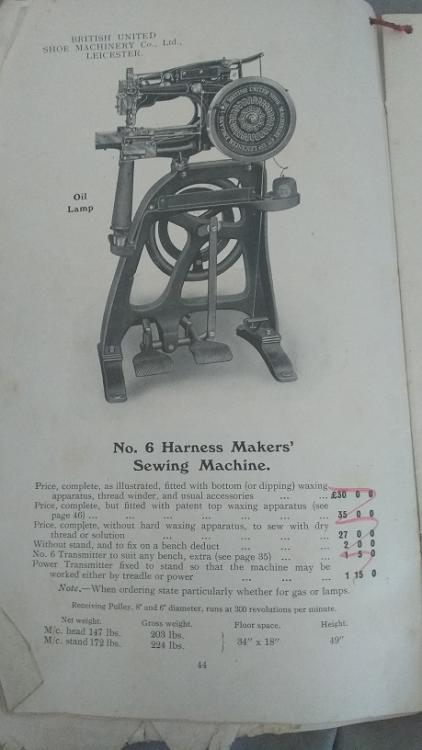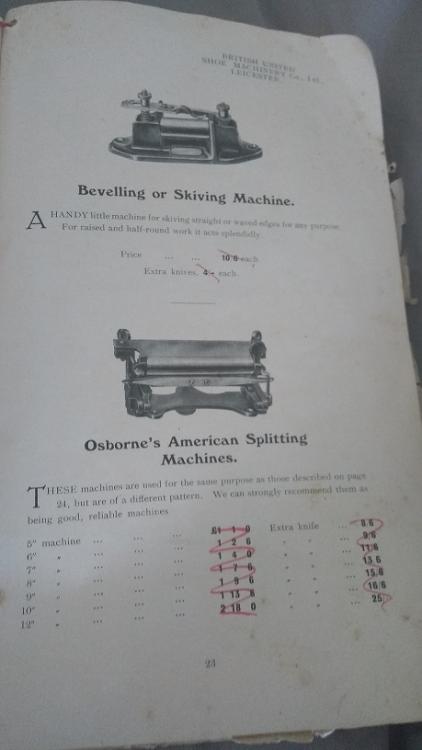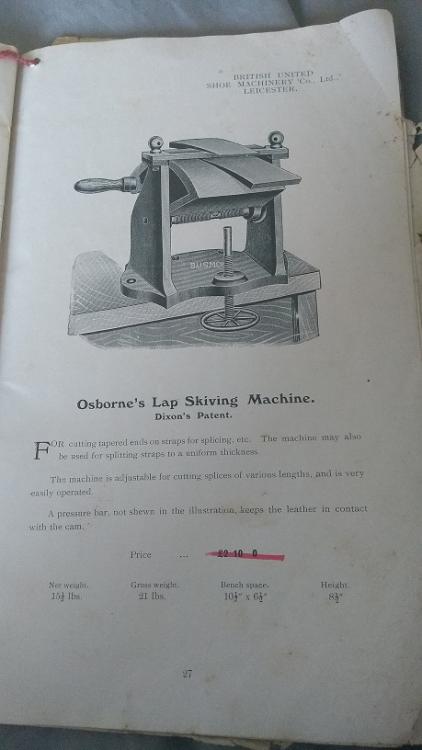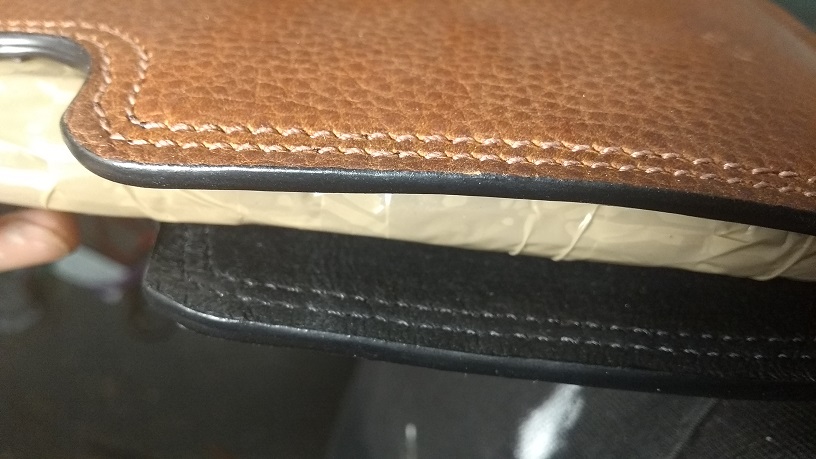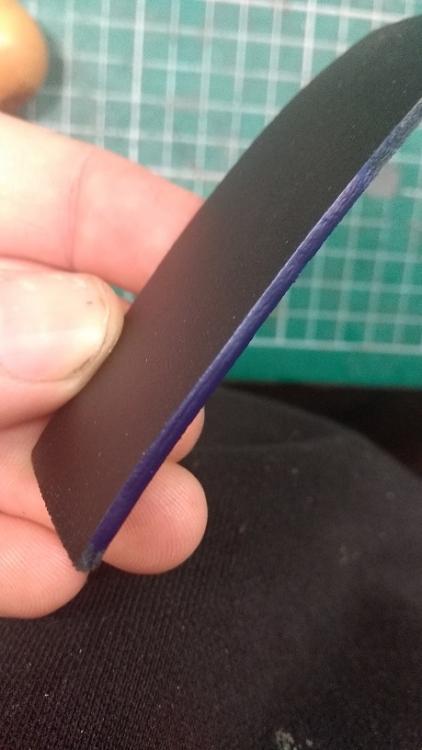-
Posts
1,806 -
Joined
Content Type
Profiles
Forums
Events
Blogs
Gallery
Everything posted by Matt S
-
Paraffin or whale oil in the lamps Harry? Thanks for the detailed response. I tend to be a bit hard on equipment so I think I'd better just pony up for a big chunk of HDPE. Most of my green mats have at least one hole from when I thought I could get away with punching "just a couple" holes. I could probably make do with a 6ft assembly/punching/general bench if I had a separate lightweight 8x4 layout/cutting table but I really can't fit both into my little shed.
-
There were two major issues that I identified: keeping the feed and pull angles consistent and the frame flexing. The angle issue is just like that on a pull lap skiver -- a matter of geometry that can be solved with concentration and care. However I found that the frame was flexing very slightly under the strain of what I was trying to do, which made the blade depth and angle bounce around. Whether these issues were inherent in the design or due to the fact I was using a Chinese knock-off I can't say. I suspect that it would flex far less with upholstery leather but don't recall ever trying it. Don't get me wrong, when it worked it was amazing -- a £80 pocket sized machine that takes razor blades costing pennies doing a job that I thought I needed a £1000 machine to do. However it was just running too much leather and I was having to work so slowly that I bought a bell skiver when a good deal came up. Never looked back.
-
There were two major issues that I identified: keeping the feed and pull angles consistent and the frame flexing. The angle issue is just like that on a pull lap skiver -- a matter of geometry that can be solved with concentration and care. However I found that the frame was flexing very slightly under the strain of what I was trying to do, which made the blade depth and angle bounce around. Whether these issues were inherent in the design or due to the fact I was using a Chinese knock-off I can't say. I suspect that it would flex far less with upholstery leather but don't recall ever trying it. Don't get me wrong, when it worked it was amazing -- a £80 pocket sized machine that takes razor blades costing pennies doing a job that I thought I needed a £1000 machine to do. However it was just running too much leather and I was having to work so slowly that I bought a bell skiver when a good deal came up. Never looked back.
-
I need to resurface my bench but I'm holding off until I've decided whether I have to leave our as 8x2 or can squeeze a 8x4 into the workshop. None of the intensive surfaces I've tried so far (chipboard, hardboard, green mats) have worked well enough so I'm going to bite the bullet on something decent, even if it is expensive. HDPE is usually what's recommended but most suppliers here in the UK only but it as 1x2 metered sheets (about 3'3"x6'6"). Full 8x2 or 8x4 sheets aren't cheap in the sorts of thickness needed but they're out there. I found the suppliers through Google and eBay. Harry those mats look handy and a good price but I'm worried about how tough they are, especially when I go heavy handed with a round knife. I'd also like a surface on which I can punch with impunity. What did you used to use in industry? Cos I'm fed up of keep spending money and ruining leather on inadequate surfaces. Full bench sized HDPE 10+mm thick is what I'm leaning towards. Yes it's an expense but if I spread that over the expected decades of use it works out pretty cheap.
-
What's the budget? A Chinese bell skiver's £1000, which means you'd get one in the States for about $1000. You'd probably get most of that back selling it on afterwards. There are little skiving machines like the Scharf-fix that take razor blades. I imported one of the Chinese copies, used it for a few months, figurated it wasn't suitable for my needs, then sold it for about what I paid for it. I wanted to step-skive medium-stiff 2+mm chrome tan for turned edges but being designed for bookbinding I think the frame wasn't stiff enough for what I wanted to do. Upholstery leather would probably be better but it'd still be awkward doing large panels. Hand skiving would be slow and awkward, but it's an option. I've got a lap skiver, a bell skiver and a crank splitter but I will daily reach for a skirt shave or skiving knife if it's a one-off. Granted I don't often skive by hand anything so spongy as upholstery leather, nor as long as a car seat panel, but it's an option that works if you keep your edge sharp. Me? I'd take it to someone who had a bell skiver and pay them some beer to do the skiving. Hint to anyone around the north west of London: I have a bell skiver and like beer. I'm not sure where STL is but I'm sure somebody on this forum has a bell skiver and is within a reasonable drive of you.
-
Depends on the thread, what it's coated with, how tight the holes are, how much rubbing occurs against the seam... It's often claimed that a saddle stitch won't unravel if one thread gets broken. Well yeah maybe, I've seen it where it has and hasn't unravelled. There's a lot of factors involved. Most threads we use in hand stitching are so strong they're unlikely to be broken in everyday use so IMHO it's a moot point. As @alpha2 states above there are exceptions, like at the mouth of a pistol holster or knife sheath, and there skilled craftspeople often reinforce with a rivet, extra stitching or a chicago screw. Yes, this is called backstitching and it's usual just to snip the thread. For linen thread 2-3 stitches is usually plenty. I find that synthetic threads, being more slippery, sometimes need a couple more. You always want to secure the end of your stitching somehow. Backstitching, tying off, melting synthetic thread, a drop of glue, or sandwiching with a rivet or other piece of hardware. What you use depends on the circumstances, and I'll often use two methods at once just for "belt and braces". If you don't secure the ends somehow, you're liable to the stitching unravelling sooner or later (usually sooner).
-
That's just a running stitch, going forward then backward to approximate the look of a saddle stitch. Notice that it doesn't lay as neatly as the saddle stitched example Is it as strong as a saddle stitch? Probably not. Will it matter on a wallet? Very probably not. Stohlman's book on hand sewing is good, but it's far from the be-all and end-all. That's not his fault, the chap was writing from a specific range of experience 40+ years ago. That book has got a lot of people hand sewing, including myself. However, frankly, I think that Nigel Armitage's youtube videos are far more useful. If a picture's worth a thousand words then a video has to be worth at least a hundred line drawings -- certainly makes things a lot clearer. Nigel also goes into things that Al can't or won't have had experience of, like the uniformity that comes of using a good English style pricking iron, or the simple ruggedness of Tiger thread. Nigel also does something that Al can't -- he responds directly to viewers' questions.
-
According to Google they were bought out by Claytons in '98, if'n you were looking for another piece I do hope that the Clayton's group can be saved.
-
Starting to look tired after only 11,300+ days of use? I'd complain to the manufacturer, clearly defective!
-
Kenneth, are you using leather-specific needles? Ones designed for fabric have a rounded, non-sharp tip designed to part woven fibres whereas needles for leather have a cutting edge on the tip, which cuts through non-woven fibres and therefore reduces blowout on the back side. There's always a difference between the top and bottom side of a seam sewn with a closed-eye needle. Apparently needle-and-awl machines are better at this but they're not very common. I find that hammering or rubbing the seam flat helps with the appearance most of the time. Looks like you have a few issues with tension too, either that the top tension is too low, bobbin tension too high, or that your thread isn't feeding evenly (top or bobbin thread). As to the corner issue either your leather is shifting under the foot, or maybe your needle is deflecting (possibly due to shifting leather). Are you glueing or taping your leather before sewing? Because that can reduce layer slippage. It may be also that your foot pressure is a little high for that thickness of leather, so it's pushing the layers a bit to the side. Just from an aesthetic POV I'd reduce the stitch length a bit with that size thread. Helps with getting the stitches to line up with corners too. Oh and one final tip: practice on scraps not projects! Keep all your scraps, even a couple inches of sewing to check your settings can save you a lot of time and money.
-
Found my old BUSM catalogue. It's missing its cover and first couple pages so I'm not sure when it dates from but the manual it came with was the 1919 edition, so I'm guessing around then. For reference, these were double the price of a Osborne of similar size: ...or 8% of a No 6 harness machine:
-
Chris, attached is a photo of Norsol (Northants Leather) navy edge paint, which I would say is a little light to be navy, more what I would call a dark royal blue. This is after 4 thin coats with a very light sand with 400 grit wet & dry between coats. They also do what looks like a slightly lighter shade, which they call royal, but I've not used it so I'm not sure exactly what the shade is. Price is about £10 for a 120ml bottle, which goes a long way. I've used a couple hundred ml of Norsol edge paints, mainly in black. They're pretty good though they don't "fill" quite as much as I'd like (maybe I'm asking too much?). Quite similar to Fenice edge paint but easier for me to get hold of. Attached also is a photo of the result of about 8 coats of black.
-
I've had somebody recently contact me regarding a dog collar for their F1 goldendoodle. Not normally an issue but they're in the US, and my liability insurance doesn't cover me for goods sold in North America so with the customer's permission I'm reaching out to other leatherworkers. I will pass on the customer's email to anybody who replies that are willing and able to fulfill her needs and pass the "sniff" test. For reference the collar she was interested in is two layers of waxy black pull-up leather, glued and sewn together for a total of 4mm thickness with a solid brass D and buckle, retailing at around GBP£20-25 for the size she needs.
-

Hydraulic shop press as a clicker press for cutting dies
Matt S replied to Anubis78's topic in Leather Machinery
I have a no2 sitting behind the shed, waiting for me to free up enough space to build it a stand. It's been about a year so far... My suspicion is that it's going to be great for quickly cranking out repetitive small parts, since it's a C-frame and will essentially a single-stroke machine. Might end up just using it for making sheet loops though!- 36 replies
-
- leather cutting die
- clicker press
- (and 9 more)
-
I don't know of any other LCW-8s for sale. However there are plenty of other similar Seiko's on eBay right now. The one you linked to looks like a CW-8. Nothing particularly special about Seiko machines, they're just relatively modern, good quality machines for which parts are quite easily available. I don't know why more sellers don't provide the model number of their machines. Luckily it's often not too difficult to detective it out with the manufacturer's website.
-
Do you need/want a cylinder bed? I'm very pleased with my Seiko LCW-8, which I picked up in a factory clearance. It would be well suited to a that sort of work, takes a very large bobbin and can be run over 2000SPM, which really speeds up those dog leads and belts! Two minor gripes: the vertical axis (top loading) bobbin is a little more prone to thread jams than a horizontal axis like on the Adler 69, and the cylinder need is a little on the chunky side. A machine like this would cost about £3k new, but plenty of similar machines are available second hand for less than a third of that.
-
Looks like a Seiko CW-7 or 8 to me.
-
If someone recommended me these domestic machines for production in leather I wouldn't darken their door again because they clearly don't understand what's needed. These machines can be used to sew a couple mm of soft-temper leather at most, but you will run into issues very frequently. In no particular order you will encounter layer slippage, uneven stitch length, short maximum stitch length, poor seam climbing, inadequate tensioning, small bobbins, inadequate foot pressure, feed-dog marks, motor stalling, inadequate penetration, timing slippage and parts breakage. They're all fine models for hemming curtains or making cushion covers but that's about the heaviest work they should be put to. It may or may not be relevant but I don't think any of these machines have been made for several decades so parts availability may be an issue. My suggestion is to get yourself a triple/compound feed (commonly known as a walking foot) machine of the upholstery weight with a servo motor. Your main choices are bed type (cylinder or flat); Chinese or premium; and new or used. New-built Chinese machines are very popular for small volume manufacturers and hobbyists because they offer a lot of features at a lower price than Japanese or German manufactured units and they're guaranteed by the dealer to work from minute 1. I don't live in the US but if I did I would expect to pay no less than $1000 for such a machine (probably closer to double that), and to resell the machine for a similar amount when I no longer needed it.
-
Using a single, very long piece of thread for a long item like a belt means you won't have any joins to hide but it will be very prone to tangling, slow and awkward to sew with (for the reasons above), light colored threads will get grubby as you go down the belt and linen thread will fray as you go down the belt. More convenient is to use no more than a fathom of thread at a time. There will be a couple joins down each side but these can usually be hidden, and most people will never notice. You can also split the difference between these two methods and use a single longish thread per side, starting at the point each time so the back stitches are hidden at the buckle end. With this method you can go down each side of the belt without any joins, but a shorter amount of thread in play at any one time. You will have to be able to sew forwards and backwards to use this approach. A normal trouser belt takes me about two hours to saddle stitch, depending of course on its length and how out of practice I am. A similar belt would take about 2 minutes to machine sew. Guess which I do more often?
-
I agree that a variable-speed hand control would be better than an on-off. However if the OP can't operate a foot pedal then an on-off hand control would be better than not being able to control the motor at all. An on-off control would indeed lose the easy speed variation that servos offer but the speed limiting, power/noise/heat reduction and needle-positioning functions would still be useful. @Noreeljob Would you be able to use your knee to control the speed? You might be able to rig the speed controller from a servo to a standard knee-lifter lever, which is a common and inexpensive part.
-

Rusty Adler 67-73 t w/ ac motor, do or don't?
Matt S replied to Badem's topic in Leather Sewing Machines
@Badem An Adler 67-63 was the first industrial sewing machine I owned. They are very well built upholstery-weight machines with good parts availability. Sadly the 67 class machines have a small bobbin by modern standards and the -63 subclass has only needle-and-drop feed rather than the more fashionable triple-feed. Their quality and utility far outweighs their current market value. That particular machine you found exhibits rust from atmospheric moisture (where the paint has rubbed off from use) rather than being rained on so I'd say it could well be in good functional condition. However the question is: will the Adler do something that your Pfaff cannot? -
My skiver doesn't have a vacuum either, but the previous owner fitted a small drawer under a big hole in the table, directly under the bell knife. Most of the time the waste very obediantly ejects itself down this hole. (I got fed up with emptying the drawer and retrofitted the retrofitted drawer into a chute with a couple SQFT of nasty PU coated split, which directs the waste into a commercial size coffee can on the floor.) I don't have many problems with hangups, with long or short slices, which is probably helped by my keeping the knife turning as fast as possible. Some non-vacuum bell skivers have a little finger of sheet metal that reaches into the hollow of the knife but doesn't quite touch the wall. I think the idea is to knock any hangups away from the knife and down the chute. Rockyaussie has provided a tutorial on how to retrofit a vacuum onto a machine that's not designed for it. I've not yet tried it but it's on my "blimey what a good idea, I must try that" list. This list gains three items for every one which gets crossed off.
-
The danger with all sorts of workshop is that equipment is a gas -- it expands to fill the space available. My shed is about 10x18ft and honestly I'm pushing the boundaries of what it can contain. Two years ago I used to fill not even half of that space, and not long before that it all fitted on a computer desk. I've already put the leather into the spare bedroom... My main workbench is 8x2ft, as that was recommended by a saddler. It's great for strap work and just about deep enough to lay out a bridle butt. However it's not much use for breaking down sides and shoulders, needs to be twice as deep, but I can't really fit a 8x4 bench around all the other stuff. I've found that the full width of workbenches can't always be used if the ends are obstructed by walls or equipment. The way I use a strap cutter, for instance, is to lay the leather off the edge of the bench and walk backwards, keeping the pulling strength and angle consistent, which gives the best results. However when my backside hits that wall, storage unit or machine, there's about 2 feet of bench left. As to height, I'm a tad under 6 foot high. My shed ceiling is about 7'6" at one side and 6'6" at the other. I ran into issues with my hammer hitting the ceiling at the top of my swing when I had my bench under the lower-ceiling area. Fewer problems at the higher end. My uncle, at least 6" taller than me, has real problems with the ceiling. I think that permitted development allows a maximum shed height of 2.4m (8 foot?) without planning permission. So, to my mind, it all depends what you want to do in terms of leather-work and what you're likely to do. Is it intended purely as a hobby, using just a few types of leather with no machines? Then you can get along with just a small space. If you have any intentions of running a business (even as a sideline), or buying any machines (whether as a hobby or business) you'll run out of space in a 12x8 fairly quickly. Sewing machines, for instance, normally occupy a table around 20x30".
-
I have seen these, in a BUSM catalogue from 100-odd years ago. Give me a few days and I'll see if I can dig it out.
-
I have run a singer 17 with a similar setup. Wanted to save a few quid and not buy a servo for a machine that would only see occasional use. It worked, after a fashion, but suffice it to say I bought a new servo motor that day.



